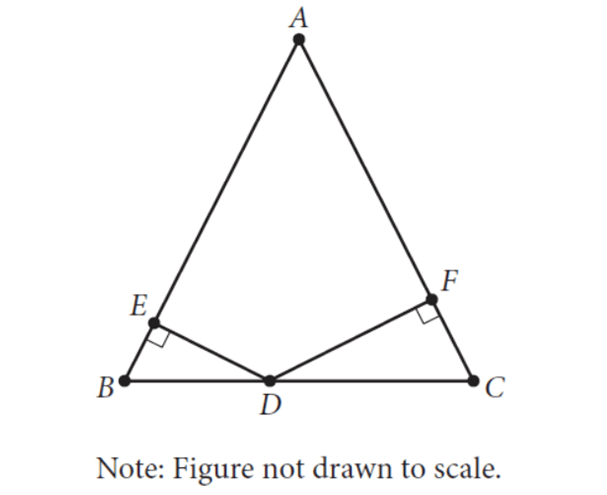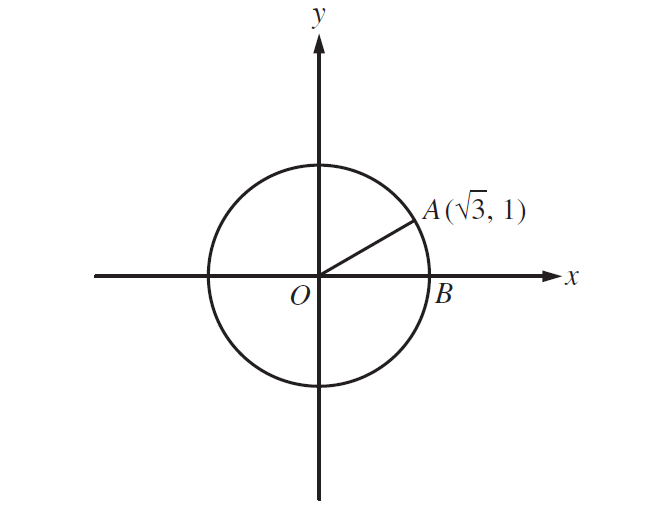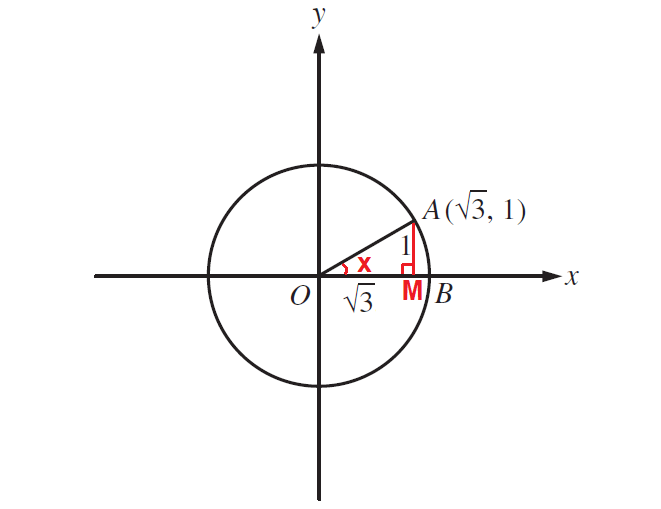DIFFICULT SAT MATH QUESTIONS
Question 1 :
Triangle ABC shown below is an isosceles triangle with AB = AC and BC = 48. The ratio of DE to DF is 5 : 7. What is the length of DC?
(A) 12 (B) 20 (C) 24 (D) 28

Answer :
In the triangle ABC shown above,
m∠E = m∠F = 90°
Since triangle ABC above is isosceles with AB = AC,
m∠B = m∠C
By Angle-Angle (AA) similarity postulate, triangles BED and CFD are similar.
DB/DC = DE/DF
Given : DE/DF = 5/7.
DB/DC = 5/7
DC/DB = 7/5
5(DC) = 7(DB) ----(1)
Given : BC = 48.
BC = 48
DB + DC = 48
DB = 48 - DC
Substitute (48 - DC) for DB in (1).
5(DC) = 7(48 - DC)
5(DC) = 336 - 7(DC)
12(DC) = 336
DC = 28
The correct answer choice is (D).
Question 2 :
To cut a lawn, Allan charges a fee of $15 for his equipment and $8.50 per hour spent cutting a lawn. Taylor charges a fee of $12 for his equipment and $9.25 per hour spent cutting a lawn. If x represents the number of hours spent cutting cutting a lawn, what are all the values of x for which Taylor's total charge is greater than Allan's total charge?
(A) x > 4
(B) 3 ≤ x ≤ 4
(C) 4 ≤ x ≤ 5
(D) x < 3
Answer :
The variable x represents the number of hours spent cutting cutting a lawn
Given : Allan charges a fee of $15for his equipment and $8.50 per hour spent cutting a lawn.
Allan's total charge = 8.50x + 15
Given : Taylor charges a fee of $12 for his equipment and $9.25 per hour spent cutting a lawn.
Taylor's total charge = 9.25x + 12
We have to find the value of x for which Taylor's total charge is greater than Allan's total charge.
Taylor's total charge > Allan's total charge
9.25x + 12 > 8.50x + 15
Subtract 8.50x from both sides.
0.75x + 12 > 15
Subtract 12 from both sides.
0.75x > 3
Divide both sides by 0.75.
x > 4
The correct answer choice is (A).
Question 3 :
The lengths of the three sides of a triangle are different prime numbers. If two of the sides have lengths 3 and 11, which of the following could be the length of the third side?
I. 7
II. 13
III. 17
(A) I only
(B) II only
(C) I and II only
(D) I, II and III only
Answer :
We have to use Triangle Inequality Theorem to solve this question. That is, sum of the lengths of any two sides of a triangle is always greater than the length of the third side.
Statement I :
If you consider 7 as the length of the third side, then the lengths of the three sides of the triangle are
3, 11 and 7
Verify Triangle Inequality Theorem for the above three side lengths of the triangle.
3 + 11 > 7 (True)
11 + 7 > 3 (True)
3 + 7 > 11 (False)
Statement I is incorrect.
Statement II :
If you consider 13 as the length of the third side, then the lengths of the three sides of the triangle are
3, 11 and 13
Verify Triangle Inequality Theorem for the above three side lengths of the triangle.
3 + 11 > 13 (True)
11 + 13 > 3 (True)
3 + 13 > 11 (True)
Statement II is correct.
Statement III :
If you consider 13 as the length of the third side, then the lengths of the three sides of the triangle are
3, 11 and 17
Verify Triangle Inequality Theorem for the above three side lengths of the triangle.
3 + 11 > 17 (False)
11 + 17 > 3 (True)
3 + 17 > 11 (True)
Statement III is incorrect.
The correct answer choice is (B).
Question 4 :
Victor wants to sell 3 watches, each at the same price. After negotiating with customers, however, he ends up selling one at a 30% discount, one at a 20% discount and one at a 10% discount. If Victor sold the watches for a total of $240, how much money did he lose by giving the discounts?
(A) $45
(B) $60
(C) $75
(D) $90
Answer :
Let x be the actual selling price of each watch.
After 30% discount, selling price of the watch :
= (100 - 30)% of x
= 70% of x
= 0.7x
After 20% discount, selling price of the watch :
= (100 - 20)% of x
= 80% of x
= 0.8x
After 10% discount, selling price of the watch :
= (100 - 10)% of x
= 90% of x
= 0.9x
Given : After discounts, Victor sold the watches for a total of $240.
0.7x + 0.8x + 0.9x = 240
2.4x = 240
Divide both sides by 2.4.
x = 100
The actual selling price (without discount) of each watch is $100.
If Victor had not given given discounts, then the total money he would have received :
= 3 x $100
= $300
Amount of money Victor lost by giving the discounts :
= $300 - $240
= $60
The correct answer choice is (D).
Question 5 :
If √x + √y = 4√y, where x > 0 and y > 0, what is x in terms of y?
(A) 16y
(B) 9y
(C) 6y
(D) 4y
Answer :
√x + √y = 4√y
Subtract √y from both sides.
(√x + √y) - √y = (4√y) - √y
√x + √y - √y = 4√y - √y
√x = 3√y
Square both sides.
(√x)2 = (3√y)2
x = (3)2(√y)2
x = 9y
The correct answer choice is (B).
Note :
Simplification of (4√y - √y) is similar to (4y - y).
We know that
4y - y = 3y
So,
4√y - √y = 3√y
Question 6 :
What is one possible value of x for which the function g above is undefined?
Answer :
We know that the square root of a negative number is imaginary or undefined.
If (x - 1)(x - 2) is negative or (x - 1)(x - 2) < 0, then g(x) is undefined.
So, we have to solve the inequality (x - 1)(x - 2) < 0 to find one possible value of x for which g(x) is undefined.
(x - 1)(x - 2) < 0
Assume the above inequality as equation and solve for x.
(x - 1)(x - 2) < 0
x - 1 = 0 or x - 2 = 0
x = 1 or x = 2
Mark the above two values of x on the real number line.

We get the following three intervals from the above number line.
(-∞, 1), (1, 2) and (2, +∞)
Check each of the above three intervals with the inequality (x - 1)(x - 2) < 0.
(-∞, 1) :
Take a random value in the interval (-∞, 1) and substitute for x into the inequality.
Let x = 0 ∈ (-∞, 1).
(0 - 1)(0 - 2) < 0
(-1)(-2) < 0
2 < 0 (False)
(1, 2) :
Take a random value in the interval (1, 2) and substitute for x into the inequality.
Let x = 1.5 ∈ (1, 2).
(1.5 - 1)(1.5 - 2) < 0
(0.5)(-0.5) < 0
-0.25 < 0 (True)
(1, +∞) :
Take a random value in the interval (1, +∞) and substitute for x into the inequality.
Let x = 2 ∈ (1, +∞).
(2 - 1)(2 - 2) < 0
(1)(0) < 0
0 < 0 (False)
When x ∈ (1, 2), (x - 1)(x - 2) < 0 and g(x) is undefined.
One possible value for x in the interval (1, 2) is 1.5 for which g(x) is undefined.
Question 7 :

In the xy-plane above, O is the center of the circle, and the measure of ∠AOB is π/a radians. What is the value of a?
Answer :
In the diagram above, draw perpendicular line AM to x-axis.

OB = √3 and AB = 1
In the right ΔOAB,
tan∠AOB = opposite side/adjacent side
tan∠AOB = AB/OB
tan∠AOB = 1/√3
tan∠AOB = 1/√3
From trigonometric ratio table, we have
tan30° = 1/√3
or
tan(π/6) = √3
Then,
∠AOB = π/6
Given : The measure of ∠AOB is π/a radians.
π/a = π/6
Take reciprocal on both sides.
a/π = 6/π
Multiply both sides by π.
a = 6
Kindly mail your feedback to v4formath@gmail.com
We always appreciate your feedback.
©All rights reserved. onlinemath4all.com
Recent Articles
-
Trigonometry Even and Odd Iidentities
May 05, 24 12:25 AM
Trigonometry Even and Odd Iidentities -
SOHCAHTOA Worksheet
May 03, 24 08:50 PM
SOHCAHTOA Worksheet -
Trigonometry Pythagorean Identities
May 02, 24 11:43 PM
Trigonometry Pythagorean Identities

